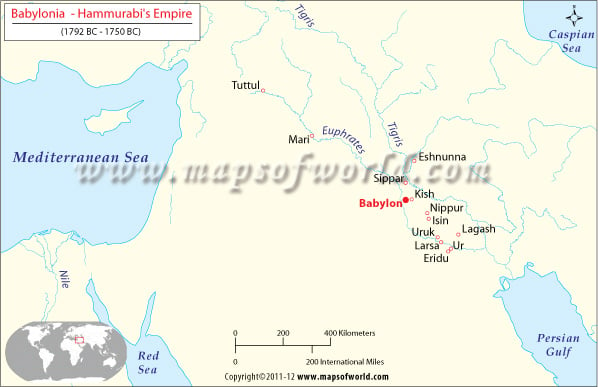The rise of Babylonia (around 1800 BC) and the Babylonian Civilization was a natural consequence of the conquest of Sumer and Akkad by the Amorites in the second millennium BC. The city-state of Babylon, on the banks of Euphrates River approximately fifty miles south of Baghdad, became the center of the Babylonian Empire. The existence of Babylon is known from the clay tablets of Sargon of Akkad.
Hammurabi
The Sixth King of the First Dynasty of Babylon, Hammurabi, is credited with the expansive conquests that laid the foundation for this empire. Having conquered most of southern and central Mesopotamia, Hammurabi went on to invade and acquire Eshnunna and Mari, the two flanks of the Assyrian Empire of King Shamshi-Adad.
The empire of Hammurabi was as big as modern-day Iraq. Hammurabi was also instrumental in binding the thirty-one city-states in Mesopotamia including Uruk, Larsa, and Nippur in an allegiance to Babylon by his administration. He dug canals and promoted prosperity in the cities he conquered. Hammurabi built temples and towers of worship to the local gods.
The greatest contribution of Hammurabi, however, was his Code of Law. Equitable laws with significant responsibility to society were the hallmarks of his legal system. Hammurabi was a great diplomat and warrior. He signed peace treaties with Assyria and the other states that he conquered. His benevolence as a king was the key to the growth of the Babylonian Empire. He reigned for forty-two years from 1792 to 1750 BC.
The Rise and Fall of Babylonia
The century following the rule of Hammurabi was a period of unrest in Babylonia. Mursil I, the Hittite king, waged a war against King Samsuditana of Babylon and rendered the empire vulnerable to an attack by the Kassites. The Kassites ruled Babylonia for over 400 years. The Kassite Empire fell to Assyrian and Elam invasions, which were finally overthrown. The Second Dynasty of Isin emerged and King Nebuchadnezzar I firmly established his dominion, having repelled the Elamites and Assyrians successfully.
Peace was short-lived and following the death of Nebuchadnezzar I, Assyrian kings frequently invaded Babylon. King Ashurbanipal was the last of the invaders to rule Babylon. The Chaldean kings who succeeded Ashurbanipal took to expanding the empire and restoring its lost glory. King Nebuchadnezzar II took the reins of the kingdom in 605 BC, and by the end of his reign in 562 BC, had invaded Jerusalem and captured the Jews of the land.
Babylon then passed on to the Persians and eventually to Alexander the Great. The decline of Babylon after Alexander’s death (323 BC) marked the end of the glorious Babylonian Empire.
Architecture and Sciences of Babylon
The Babylonian kings prided themselves on their splendid architectural ventures. King Nebuchadnezzar II was credited with having built some of the ancient marvels including the Hanging Gardens of Babylon, the Gates of Ishtar, the Temple of Marduk, as well as reconstructing the Tower of Babel. The palaces, temples, and edifices of ancient Babylon are marvelous constructions that inspire awe in historians and archeologists.
Ancient Babylonians were precise astronomers and mathematicians. The Venus Tablets from the era of Ammisaduqua provide adequate evidence that the Babylonians not only used their temples for worship, but also observed and recorded the movement of celestial bodies. This allowed them to predict the course of planets and constellations as well.

 Ancient Japan History
Ancient Japan History